![]() Download the PDF (1 MB)
Download the PDF (1 MB)
Read on Texas Scholar Works
By Denise Schmandt-Besserat
Abstract: A unique stone statuette, 14 cm high, glorifies pregnancy. The sophisticated geometric composition of the sculpture, based on triangular and circular arrangements, exalts a woman and her bulging stomach, while the material, a pink limestone, celebrates her nudity. The statuette was found in situ, face down, at the end of a stone path, where it might have been displayed for worship in a small shrine of perishable material. The context in which the statuette was recovered suggests that, like their Bronze Age descendants, the early farmers used pregnancy as a metaphor for origin mysteries or the bounty of nature.
Key Words: stone sculpture in the round, female, pregnancy, deity, worship
The stone statuette from ‘Ain Ghazal shows a nude figure whose gender is not immediately apparent (Rollefson 2008: 94; 2000: 178; Kafafi and Rollefson 1994; 1995: 24-25; Kafafi n.d.). The genitals are not indicated and the breasts are flat. However, the absence of musculature, the abdominal fat rolls, the voluminous upper arms and thighs are clues that the subject is female. Mostly, the attention given to the womb, its enormous size, its central place in the composition, the way it projects in profile, and the gesture cradling it, makes it unequivocal that the figure is pregnant (Figs. 5.1.1-5.1.2). Who is the female exalting her pregnant state? Who is the child? What did the figure mean to the Neolithic villagers? These are questions that the artifact alone or the shreds of evidence left at the site cannot answer. In this paper I seek to address these questions by analyzing the context, technology, and style of the statuette. I place the piece in the iconography by comparing it with ‘Ain Ghazal clay figurines and with early Levantine stone sculptures. Then I glean information in the mythology, considering the role of pregnancy in ancient Near Eastern creation myths. Based on the collected data, I will propose that the statuette is part of a long tradition of women procreators of cosmos and vegetation.
The Context
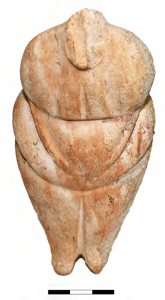
The statuette was excavated in 1994 at ‘Ain Ghazal. The field number is as follows: AG 1994: NF 5516, locus 002, bag 3, MC 1. The stone figure originated from the Pre-Pottery Neolithic C (PPNC) period, dated from 6900 to 6400 BC. This phase of occupation at the site was marked by a ravaged environment generally held responsible for a decreased local productivity and an impoverished material culture (see Rollefson and Kafafi, chapter 1). In particular, the cultic architecture was merely reused or renovated (Rollefson 2008: 91) and the number of human and animal representations in clay and plaster dwindled (Rollefson 2000: 178-180). The degradation of the ecosystem was inherited from the previous PPNB period, when the people overgrazed, over-farmed, and deforested the region, aggravating the effects of a change of climate (BarYosef and Meadow 1994: 44). The general depopulation eventually led to a shift in the way of life from farming to nomadic pastoralism (Rollefson and Köhler-Rollefson 1993: 33-42).
The figurine was located far above the wadi, in an area presumably situated at the outskirts of the village. It was found in situ, lying face down (Fig. 5.1.3) at the end of a stone path about 2 meters long, consisting of some fifteen tightly aligned slabs (Fig. 5.1.4). This suggests that the female image was reached by a specially prepared stone pathway. Since no structural remains were detected in excavation, it is possible that the sculpture was displayed on a small platform made of perishable material, such as reeds or wood. If this was so, the statuette could have fallen face down when the flimsy edifice collapsed, either after a conflagration or the abandonment of that part of the site. No other feature was identified in the vicinity except for a thin stone wall, perhaps a courtyard enclosure, running roughly parallel to the path.
The Technology
When the statuette was excavated, it was covered by a thick coat of mineral deposit, which was partly removed in laboratory. The pink, veined limestone (Munsell 7.5YR 7/4) is now visible in the front and left side of the figurine. Broken in antiquity, the head, calves (and feet?) are now missing. In its present state the statuette is 14 cm high, 5 cm thick, 5.5 cm wide at the shoulders, and 7 cm at the hips.
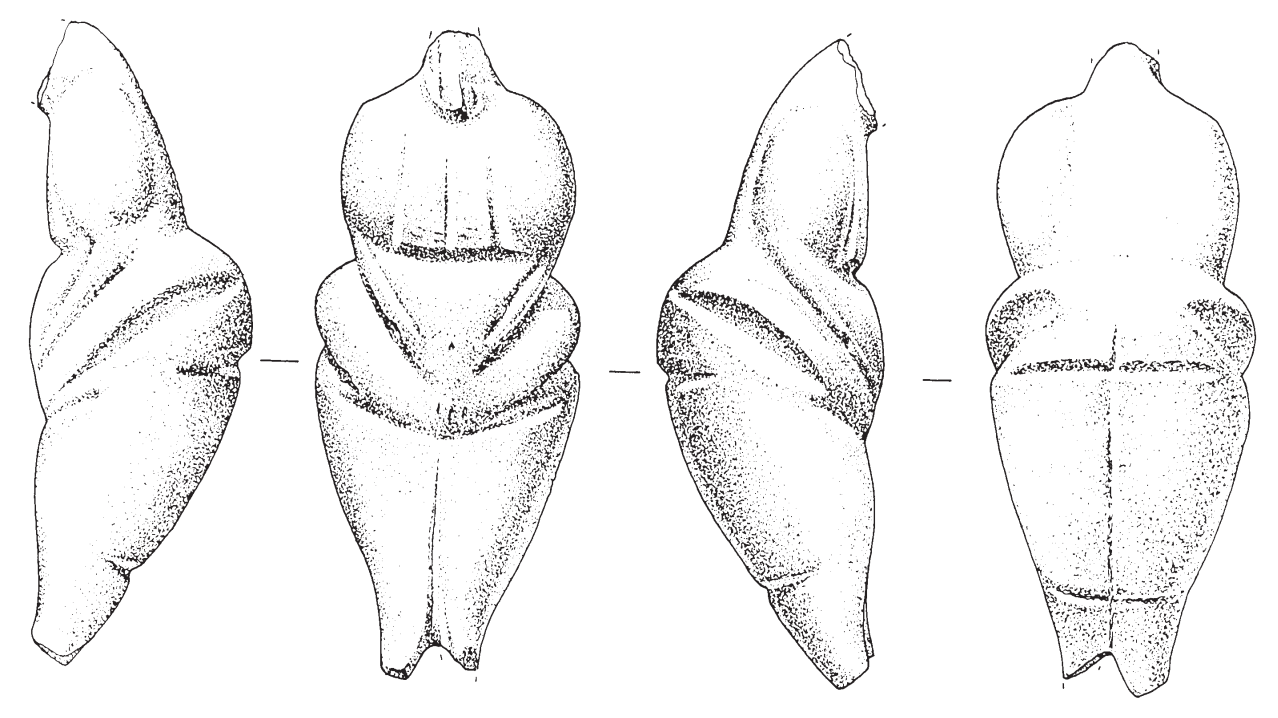
The figure is carved in the round, with equal care given to all sides. The sensitive modeling, especially successful in translating the fleshy parts of the body such as the waist and shoulders, is a testimony to Neolithic stone technology. It shows that sculpture, at least in a small format and in a relatively soft limestone, had few limitations for the early stone carver. The sophistication of the composition, which as will be described below was based on the interplay of lines and curves, makes it unlikely that it was dictated by the original stone block, as is usually implied for prehistoric sculptures. Instead, it suggests that the artist first created a model in a softer material, perhaps tuber, wood, clay, dough, or wax, before turning to stone. In the absence of lithic replication studies, the carving technique can presently only be speculated upon (Wilke and Quintero 1994: 33-60). It probably implied pecking and chipping the limestone block with a stone tool to achieve a rough form of the desired size. The female body was then disengaged by grinding selected areas with gritty stones. It is noteworthy that the transitions are remarkably executed. For instance, the arms do not end abruptly at the wrist, but the unformed hands give the impression of melting into the mass of the abdomen. The grooves outlining the breasts, thighs, and fat rolls were engraved with a pointed tool. Finally, the surface was smoothed with rubbing stones of decreasing roughness. Dark red speckles (Munsell 2.5YR 4/4 reddish brown) all along the right side, from the upper arm to the thigh, show that the statuette was painted.
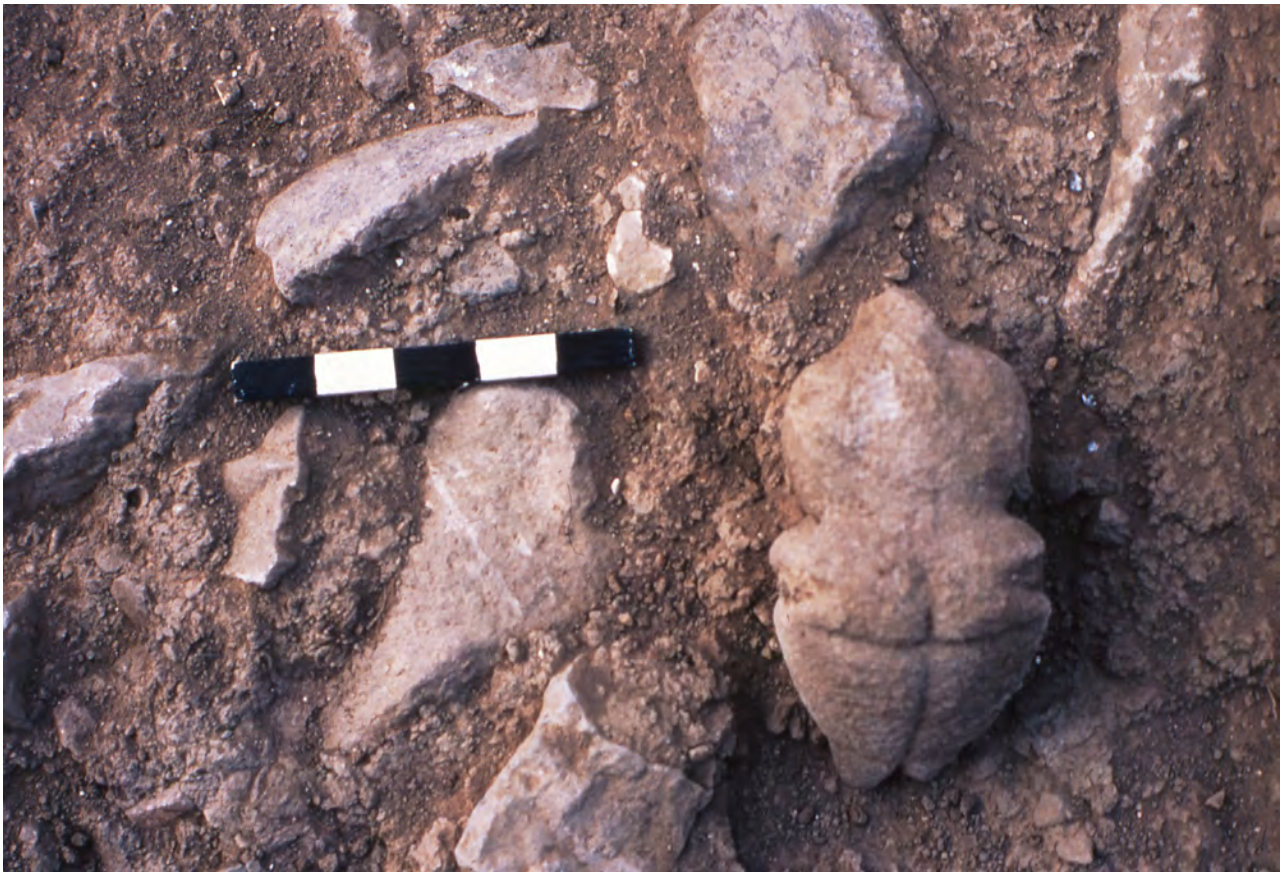
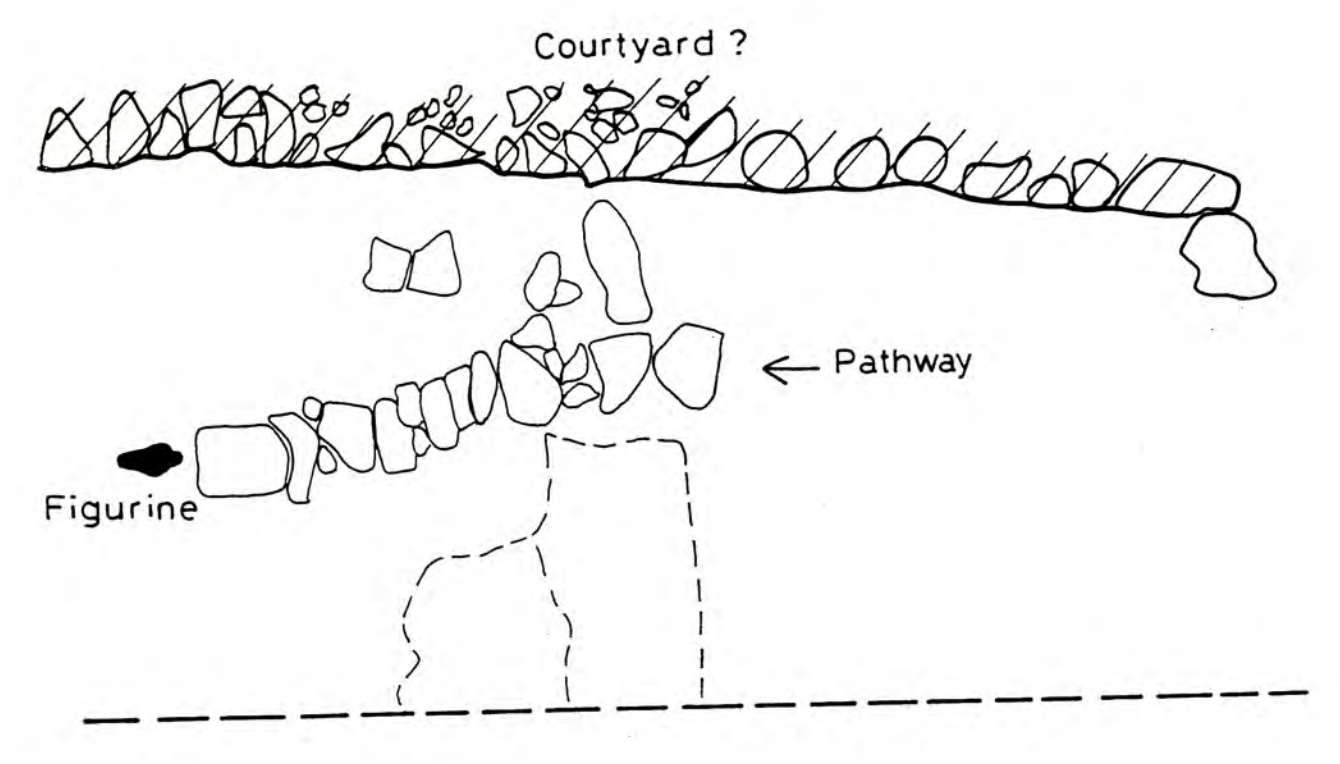
The Style
Nothing in the statuette can be credited to chance or mere imitation of nature. Instead, the female form is cast in an elaborate geometric framework (Fig. 5.1.5). To start with, the image is built around a vertical axis beginning between the breasts and continuing along the thighs. Shoulders, arms, breasts, fatty rolls, thighs, and knees are symmetrically arranged around this central line, but the womb bursts out in the center, at the focal point of the figurine. Then, deep, clearly marked horizontal grooves divide the body into three parts, the abdomen again occupying the center. Finally, the stomach is bracketed between a triple set of diagonal lines. The grooves descending along the breasts widen towards the abdomen, driving the eyes on to it. In the opposite direction, the little arms form a double set of parallels that emphatically close the center of attention below the pregnant womb.

The most masterful part of the composition is the successful blending of the rigorous linear inner design with the outline of curves cascading along the shoulders, waist, hips, and thighs. Moreover, lines and curves combine to create geometric patterns. The semicircle of the shoulders mirrors that of the fat rolls, enclosing the torso into a full circle. Triangles are a leitmotif. Breasts, lower arms, and thighs are made into three triangles switching directions. Finally, the tip of the stomach and the two upper arms form a last imposing triangle.
Everything in the sculpture is calculated to bring the pregnant womb into focus. The lozenge composition emphasizes the round abdomen by featuring both extremities of the body tapering off symmetrically on either side (Pls. 5.1.1a-d). The style manipulates the female form to showcase the bulging stomach. Some body parts are entirely eliminated. Among them are genitalia, navel, elbows, hands, fingers, armpits, and neck. The chest and limbs are minimized. The breasts are flat, linear, and show no nipples. As a result, the streamlined composition concentrates upon selected fleshy parts of the body: the upper arms, thighs, fat rolls, and mostly, the inflated stomach. Proportions are skewed in order to emphasize the abdomen. The enormous arms taper to minuscule limbs as they reach over the stomach. The torso is lengthened to match the size of the legs so that the womb occupies the center of the figurine. Moreover, body masses are shifted. The switch between breasts and arms is perhaps most remarkable. The breasts are flat but the upper arms bulge, round and voluptuous. Finally, the buttocks are lifted to the height of the abdomen. As a result, the woman enshrines her womb with her bent head, raised thighs, and folded arms.
The Iconography: A Comparison With The ‘Ain Ghazal Clay Figurines
‘Ain Ghazal produced a collection of forty-nine human clay figurines (see Schmandt-Besserat, chapter 4.1). It must be significant that the villagers produced female representations in both stone and clay. It must also be meaningful that the two genres have little in common. The analysis of their similarities and disparities may provide clues to their respective importance.
To start with, both stone and clay figurines depicted humans, but the form differs. The clay pieces are usually cursorily done, reducing the body to a mere cone pinched at the base into two pointed legs (see chapter 4.1, Fig. 4.1.1). In contrast, the stone sculpture was executed with careful planning. It shows the mastery of aesthetic principles such as symmetry and geometry. In particular, the triangles and lozenges intrinsic to the composition of the statuette are absent in the clay examples.
The two types of figurines featured femininity in a different style. The three females made of clay have prominent breasts and are dressed with an all-covering impressed garment (see chapter 4.1, Fig. 4.1.2), whereas the statuette is flat-chested and stresses nudity.
The two types of objects belong to different periods. The majority of the clay figurines date of the Middle Pre-Pottery Neolithic B (MPPNB), ca.8500-7500 BC when ‘Ain Ghazal was a prosperous agricultural community. On the other hand, the stone statuette is of the following PPNC period marked by an economic and cultural decline and the intensification of a new way of life based on pastoral nomadism (Rollefson 2008: 91; Rollefson and Kafafi 2007: 217). The architecture also reflects a difference in worshiping. The architecture of MPPNB is domestic but cultic apsidal structures and a “special building” or “temple” appear in the Late Pre-Pottery Neolithic B (LPPNB) ca.7500-6900 BC (Rollefson 1998: 51-54) and continue to be reused and renovated during the PPNC period (Rollefson 2008: 87-88; 2000: 179; 1997: 294-298).
Furthermore, the context of each of the two types of anthropomorphic representations indicates separate functions. The clay figurines are consistently part of the fill, mixed with ashes, charcoal, and other refuse, implying that they were thrown away after use because they had no intrinsic value. In contrast, the sculpture was recovered in what seems a formal context, suggesting that it was displayed in some fashion and could be visited by the villagers through a specially prepared pathway.
The discrepancy in the number of stone versus clay figurines is substantial. There is one stone statuette compared to forty-nine clay figurines indicating that the clay representations were common, but those of stone, rare. The choice of clay vs. stone implied different expectations. Clay is a common, ubiquitous material. Pinching tiny figures is done quickly, by hand, without any tool. It requires no prior training or competence. Clay artifacts, when unfired, are exceedingly fragile and therefore have a limited lifetime. On the other hand, flesh-colored stone was perhaps endowed with mystical qualities conferring special powers to the sculpture. Moreover, carving stone denotes a concern for durability, a commitment of time and energy, skill, the knowledge of the craft, and a specialized tool kit.
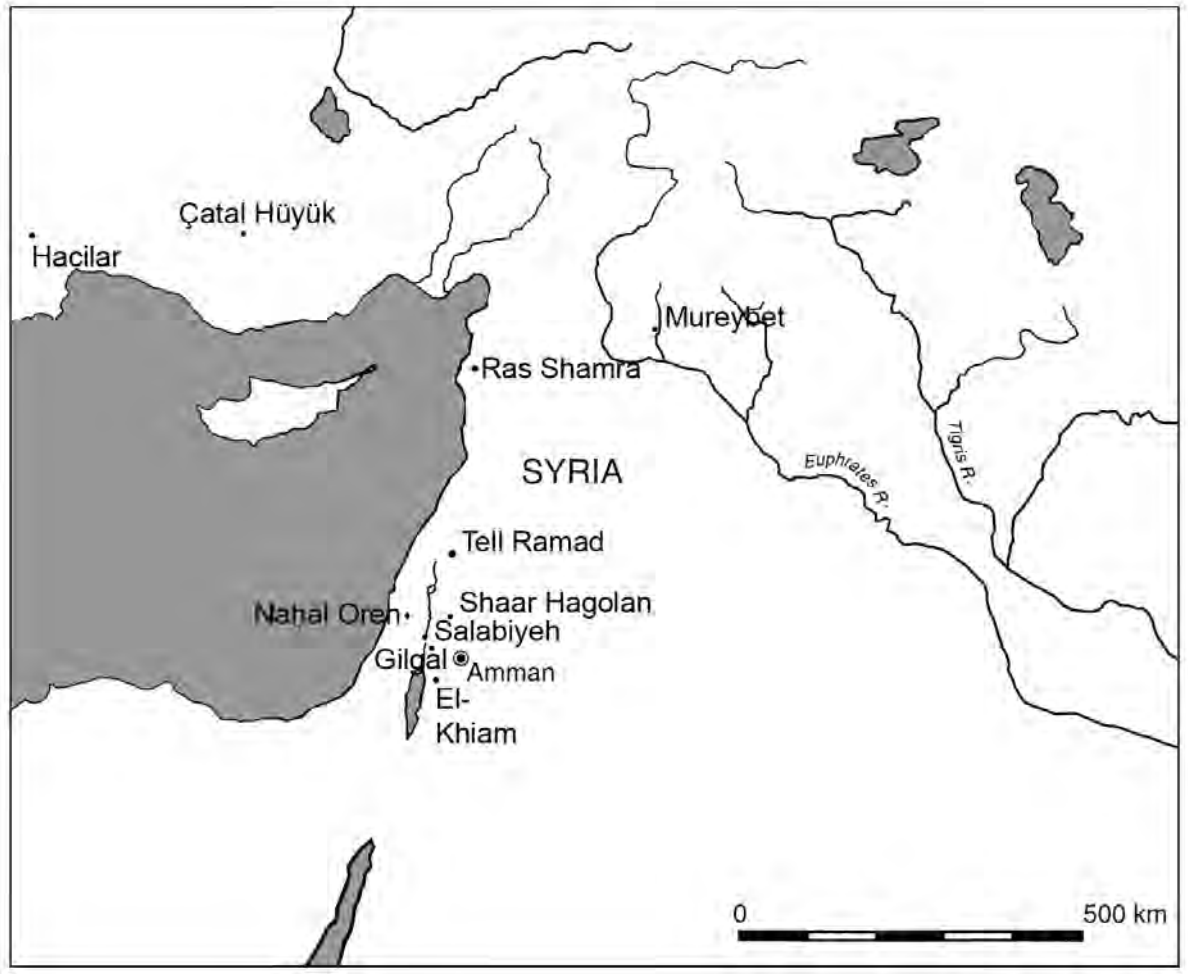
The size of the figurines further underscores their relative importance. The stone statuette is hand-size. The clay figurines are minuscule, measuring 3-5 cm, which precluded a public display. The figures’ postures point to a different handling. The seated position of most of the clay figurines suggests that they were meant to be stable without support. Instead, the stone statuette can neither stand, nor sit, nor lie. It had to be displayed in a throne that held it upright. It may also be significant that the figurine fits perfectly in the hand, the buttocks nestling snugly in the palm and the side grooves providing a firm grip. The statuette primary function, therefore, was perhaps to be held in the hand by an individual in order to present it to an audience.
In sum, the analysis of the fifty anthropomorphic figurines of ‘Ain Ghazal shows that the stone and clay specimens shared the human form and often femininity. Otherwise, the two genres differed in treatment, style, chronology, context, number, technology, and in size as well as form. The more numerous clay figurines, made of a common material, with little investment of time and energy and discarded with other refuse, suggest brief domestic use, probably related to magic. Instead, the statuette’s more durable material, complex technology, special context, elaborate form, aesthetic composition and emphatic symbolism denote a valued artifact, destined for a formal, public function (Kafafi 1991: 12-14).
The distinction between the domestic use of clay figurines and the public function of the stone statuette is important because it matches the developments in architecture. Although it was found in an open-air space, the statuette is contemporaneous with a tradition of worship in public cultic edifices (Rollefson 2008: 91; 2000: 178-181). It is therefore likely that the ‘Ain Ghazal female stands at the origin of the long tradition of female stone statuary known from excavations to have been used in temples and shrines (Foster 1993: 33). As soon as inscriptions on statues, royal texts, temple inventories, and hymns become available in the early historical period, they leave no doubt that the female stone effigies, as a rule, represented deities. Following Durkheim (1976: 30), I call deity, divinity, god or goddess, “spiritual beings … conscious subjects gifted with powers superior to those possessed by common men.” The main function of icons was to personify some of these supernatural forces, suggesting that they resided in the community and could be propitiated by cultic ceremonies, offerings, and prayers. This role of cultic statuary is not difficult to grasp since it is not particular to the Near East or to prehistory, but quasi-universal (Beaulieu 1993: 241).
The Iconography: The Early Levantine Stone Statuary
Although the PPNB clay figurines preceded the stone statuette, they did not serve as prototypes. The antecedents of the ‘Ain Ghazal female may rather be sought in the early Levantine stone statuary (Kuijt and Chesson 2007: 221-222) (Fig. 5.1.6). The first anthropomorphic representations consisted mostly of pebbles carved in the form of a phallus (Perrot 1966: Figs. 2-3 and Photos 11-12) that appeared in Natufian assemblages ca.10,000 BC. The same culture is also traditionally credited (Cauvin 1978: 118-119) for a small calcite statuette depicting a couple in coitus, with the two bodies tightly clutched together (Neuville 1933: 558-560) (Fig. 5.1.7). It is noteworthy that the theme of the embraced couple was not unique to the Natufians or to the Levant. The motif of the copulating couple reoccurs, for example, in Anatolian sculptures of the 7th millennium BC at Çatal Hüyük (Mellaart 1967: Pl. 83) (Fig. 5.1.8) and as a seal of Protohistoric Susa (Amiet 1972: 2, Pl. 58: 414).
When individual figures started being carved in the 10th millennium BC, in the Pre-Pottery Neolithic A (PPNA) Khiamian culture, most were sexually ambiguous or even dual-gendered representations (Bar-Yosef 1980: 193-199, Figs. 3-4). Examples at Salibiya, Nahal Oren, and Gilgal, on the one hand, depict the body of a woman with a head barely disengaged from the shoulders, facial features reduced to the brows and a long nose, and with the trunk ending in two stumpy thighs (Fig. 5.1.9a, b, and d). On the other hand, the figures can also be viewed as male genitalia: the nose and brows become the foreskin, the body is the phallus, and the thighs represent the testicles (Gopher and Orelle 1996: 255). The bisexual style was not confined to the PPNA culture but was still alive as late as the 6th millennium BC at Shaar Golan, where pebble figurines still fused the male sex with the female body (Stekelis 1972: 25-27, Pl. 50: 1, 51: 1, 52: 1) (Figs. 5.1.10-5.1.11). In fact, bisexuality, far from being restricted to the Mediterranean coast, was celebrated in a statuette as late as ca.4500 BC and as far as Tepe Yahya in southern Iran (Lamberg-Karlovsky and Meadow: 1970: 14).
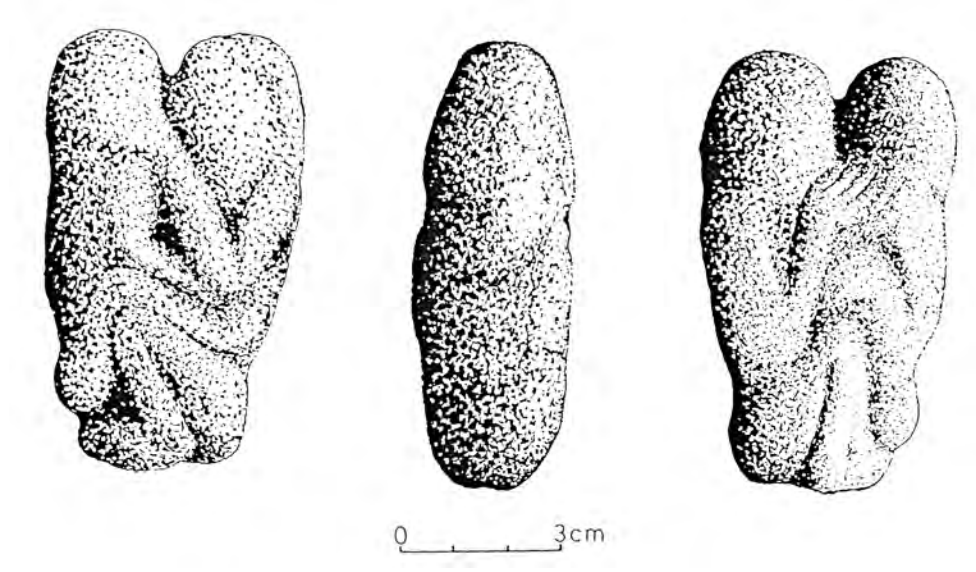
Female sculpture in the Levant also coincided with the beginning of agriculture in the Khiamian culture, ca.10,000 BC. These few PPNA stone figurines from El Khiam and Mureybet II (Fig. 5.1.9c, e) depict women that are singular in having no breasts, navels, or genitalia. The buttocks are often emphasized, producing a characteristic arching posture. The Gilgal figurine has facial features such as brows and nose but is reduced to a torso. (BarYosef, Goring-Morris and Gopher 2010: 200, Fig. 11.11) (Fig. 5.1.9d) The stylization becomes even more extreme in the following millennia, as shown by figures of Mureybet III in the 10th millennium (Cauvin 1978: 121, Fig. 25: 3), Tell Ramad II (Contenson 1966: 170, 173, Pl. 2C) as well as Ras Shamra V in the 8th millennium (Schaeffer 1962: 154, Fig. 1A). The figures are then reduced to a torso with stumpy legs, omitting head, arms, breasts, navels, and usually sex. A single specimen from Mureybet features a vulva (Fig. 5.1.12). These statuettes also preserve the triangular profile noted in the PPNA prototypes. It was noted above that intercourse and bisexual representations were not restricted to the ancient province of Palestine, but were attested as far north as Turkey and as far east as Iran, respectively. The same is true for the flat-chested female stone statuettes. For example, level VI A at Çatal Hüyük, produced a figurine that is far more naturalistic, but still retains the same characteristic triangular profile and has no breasts, navel, or vulva (Mellaart 1967: Pl. 80) (Fig. 5.1.13). It is noteworthy, therefore, that at Çatal Hüyük, as well as at Hacilar, pregnancy is translated in the informal clay figurines, not in the more complex stone statuettes. The fact that the Levant shares themes and style with other regions demonstrates that the Mediterranean coast was not isolated. The stone images belonged to a Pan-Near Eastern Neolithic phenomenon.
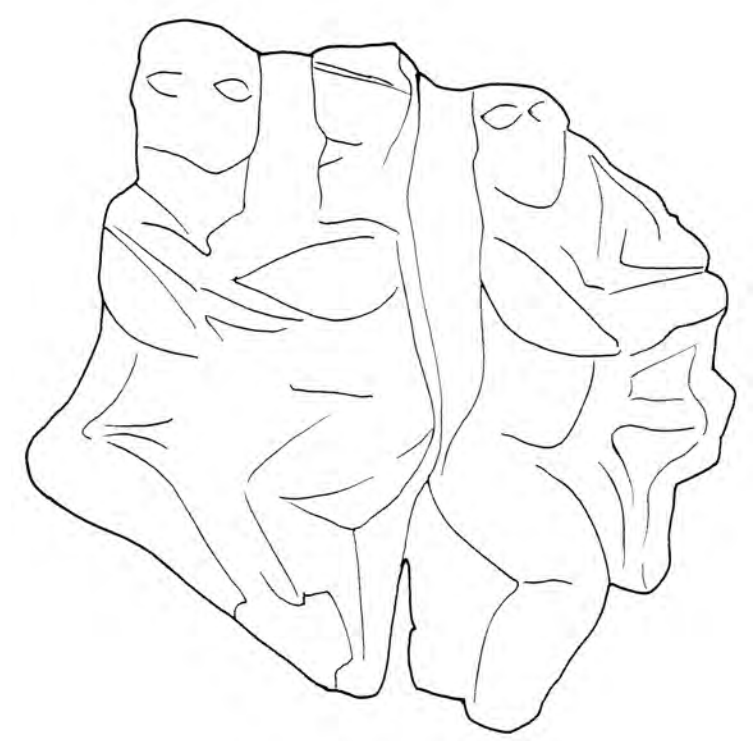
The ‘Ain Ghazal figure was thus similar to the previous and contemporaneous statuettes for the choice of stone, art form, size, and triangular profile. Like the other female images, the woman was depicted with flat breasts, and no navel or genitalia. However, it departed from the former tradition in significant ways. It was far more naturalistic since, except for hands and nipples, it depicted each and every part of the human body. It was novel in the treatment of obesity, i.e. the exaggeration of the upper arms and abdominal fat rolls. More importantly, it was first in glorifying pregnancy. In particular, the gesture of holding the womb has also no known antecedents. Finally, the ‘Ain Ghazal figure surpassed her Levantine sisters by the slick composition and the skillful use of symmetry, triangles, and lozenges that endowed the statuette with an unmatched mystical quality.
The ‘Ain Ghazal female further inherited from the past the theme of propagation (Cauvin 1994). It shared with the early Natufian phallic images, the copulating pair, and the PPNA bisexual figures the same concern with sexuality or reproduction (Perrot 1966: Fig. 21: 1, 10, 13). But it was a new interpretation. The statuette did not feature bisexuality or intercourse, but a woman ready to give birth. In other words, it did not picture conception, but pregnancy.
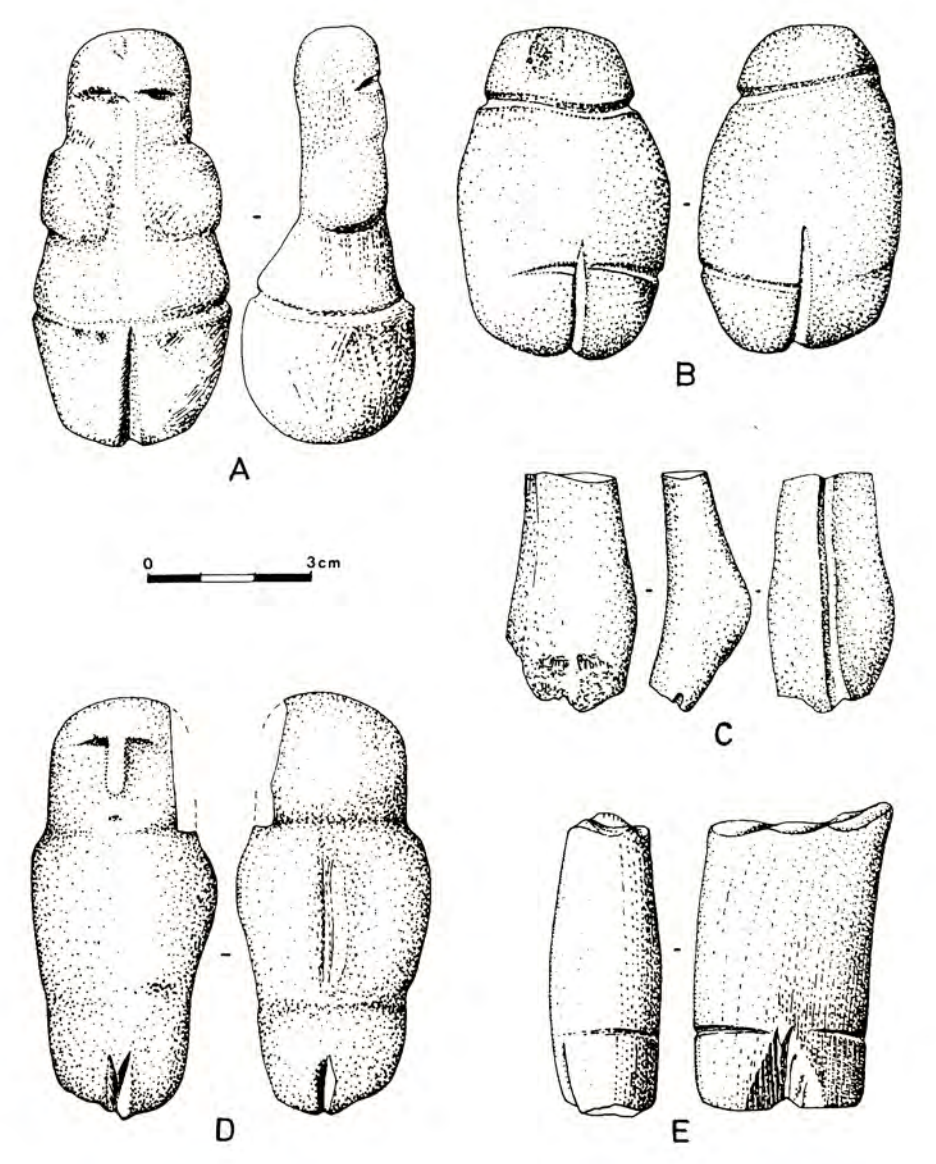
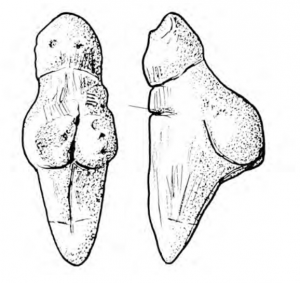
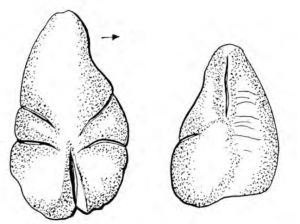
4.5, TH. 4.1. After Stekelis 1972: Pl. 51:1.
The Mythology
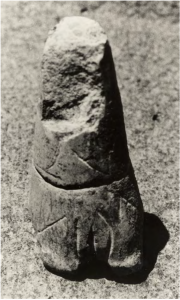
Intercourse, bisexuality, and pregnancy exalted in stone sculpture also played an important role in ancient Near Eastern mythology. The cuneiform literature gives multiple examples when child bearing is used as a metaphor to express the mysteries of origins. For example, the beginning of the universe was conceived as a divine procreation. Nammu, the lone primeval deity, gave birth to An-Ki, sky and earth, with no male partner (Wiggerman 1992: 289-293). In other words, the ultimate beginning of the universe was viewed as the fruit of bisexuality. An-Ki were the tightly embraced, inseparable pair who, in turn, begot the various components of nature, water, wind, the sun, the moon and all the stars. The idea that all existing things were ultimately the result of sexual conception pervaded the ancient Near East. The Egyptian creation myths echo those of Mesopotamia. Their demiurge Atum had a progeny without a female, by masturbation. Among his children, the brother and sister couple Geb and Nut, Earth and Sky, were intimately embraced until being separated by Shu, personifying Air (Hart 1990: 14). The bounty of nature renewed by each season was also conceived as resulting of divine sexual intercourse. Ki was one of the early female Mesopotamian deities, who was credited for generating earthly vegetation by sleeping with An (Black and Green 1992: 112- 113). But the prevalent tradition from the Sumerian to the Babylonian period held that Inanna / Ishtar was responsible for the seasonal germination of plants and the propagation of the flocks in the spring through intercourse with Dumuzi.

Can the Near Eastern mythology give a clue to the significance of the early sculptures? Could the bisexual figures evoke primeval deities like Nammu? Could the loving pairs represent inseparable godly couples, antecedents of An-Ki? And finally, could the ‘Ain Ghazal statuette embody a mythical female engendering fertile crops? These questions are warranted first because the myths recorded in the cuneiform literature were not short-lived stories. Well on the contrary, it is commonly held that the mythological texts recorded on tablets had their roots deep in the past, probably as far back as the prehistoric oral tradition (Postgate 1994: 176-180). They were the product of the accumulated experience of innumerable generations and therefore express a timeless Near Eastern cosmology. The hypothesis is also particularly plausible because people of innumerable societies have used the tangible experience of sexual conception and pregnancy to explain the mystery of life.
Conclusion: The Significance
If indeed the woman cradling her womb was a metaphor of creation carved in stone, the statuette gives important insights into the rituals and beliefs of PPNC ‘Ain Ghazal. First, it provides the evidence that icons were used to revere deities. Moreover, the time and energy invested in carving stone manifest that the divine images were deemed important. The context in which the statuette was found indicates that, whereas special ritual edifices were being built at ‘Ain Ghazal, the icon was visited by worshippers in an open place on the outskirts of the village. The similarities of the statuette with earlier PPNA and PPNB sculptures suggests that the sculptures served a same purpose and were used according to a long established cultic tradition. In particular, the peculiar triangular profile implies that the icons were displayed in a similar way, perhaps involving a small throne, or, since they fit the hand so perfectly, were held by an individual during cultic ceremonies.
The statuette also reveals that the early farmers’ pantheon included supernatural beings in the shape of pregnant women, which differed from earthy females by having flat breasts and no navel or genitalia. More importantly, the fact that PPNC ‘Ain Ghazal departed from the flat-chested women representation denotes an evolution in symbolism. The pregnant, obese woman may therefore indicate that climate change and the deterioration of the environment stimulated a change in the cosmology. Pressing concerns for plentiful harvests and herd reproduction inspired a new cult centering on life-giving females.
Acknowledgments: An earlier version of the chapter was published in 1998 in Near Eastern Archaeology 61.2: 109-117. The study was funded by a Faculty Research Assignment Grant from the University of Texas Research Institute.
Bibliography
Amiet P.
1972 – Glyptique Susienne, des Origines à l’Epoque des Perses Acheménides, Vol. 2. Mémoires de la Délégation Archéologique en Iran 43. Paris: Librairie Orientaliste Paul Geuthner.
Bar-Yosef O.
1980 A human figurine from a Khiamian site in the Lower Jordan Valley. Paleorient 6: 193-199.
Bar-Yosef O. Goring-Morris N and Gopher A.
2010 – Gilgal. Oxford: Oxbow Books
Bar-Yosef O. and Meadow R.H.
1995 – The origins of agriculture in the Near East. In T.D. Price and A.B. Gebauer (eds.), Last Hunters, First Farmers: New Perspectives on the Prehistoric Transition to Agriculture: 44-45. Santa Fe: School of American Research Press.
Beaulieu P.
1993 – An episode in the fall of Babylon to the Persians. Journal of Near Eastern Studies 52/4: 241-262.
Black J. and Green A.
1992 – Gods, Demons and Symbols of Ancient Mesopotamia. Austin: University of Texas Press.
Cauvin J.
1978 – Les Premiers Villages de Syrie-Palestine du Xième Millénaire Avant J.C. Collection de la Maison de l’Orient Méditerranéen Ancien 4, Série Archéologique 3. Lyon: Maison de l’Orient.
1994 – Naissance des Divinités, Naissance de l’Agriculture, Paris: CNRS Editions.
Contenson H. de
1966 – Seconde campagne à Tell Ramad, rapport préliminaire, 1965. Annales Archéologiques Arabes Syriennes 16: 167-174.
Durkheim E.
1976 – The Elementary Forms of the Religious Life. London: George Allen and Unwin.
Foster B.R.
1993 – Before the Muses. Bethesda, MD: CDL Press.
Gopher A. and Orelle E.
1996 – An alternative interpretation for the material imagery of the Yarmukian, a Neolithic culture of the sixth millennium BC in the southern Levant. Cambridge Journal of Archaeology 6/2: 255-279.
Hart G.
1990 – Egyptian Myths. Austin: University of Texas Press.
Kafafi Z.
1991 – The role of women in the Stone Age: preliminary ideas. [in Arabic] Newsletter of the Institute of Archaeology and Anthropology, Yarmouk University 11: 12-14.
2000 A unique PPNC female figurine from ‘Ain Ghazal. In L.E. Stager, et al. (eds.), The Archaeology of Jordan and Beyond: Essays in Honor of James Sauer: 235-237. Winona Lake, IN: Eisenbrauns.
Kafafi Z. and Rollefson G.O.
1994 – ‘Ain Ghazal 1993-1994. Biblical Archaeologist 57/4: 239-241.
1995 – The 1994 Excavations at ‘Ain Ghazal: Preliminary Report. Annual of the Department of Antiquities of Jordan 39: 13-29.
Kohler-Rollefson I.
1988 – The aftermath of the Neolithic Revolution in the light of ecological and ethnographic evidence. Paléorient 14/1: 87-93.
Kuijt, I. and Chesson, M. S.
2007 – Imagery and social relationships: shifting identity and ambiguity in the Neolithic. In C. Renfrew and I. Morley (eds.), Image and Imagination. Mc Donald Institute Monographs: 211-226. Cambridge: McDonald Institute for Archaelogical Research.
Lamberg-Karlovsky C.C. and Meadow R.
1970 – A unique female figurine. Archaeology 23/1: 13-17.
Mellaart J.
1967 – Çatal Hüyük: A Neolithic Town in Anatolia. New York: McGraw-Hill.
Neuville R.
1933 – Statue erotique du Désert de Judée. L’Anthropologie 43: 558-560.
Perrot J.
1966 – Le Gisement Natoufien de Mallaha (Eynan), Israël. L’Anthropologie 70/5-6: 437-483.
Postgate J. N.
1994 – Text and figure in ancient Mesopotamia: match and mismatch. In C. Renfrew and E.B.W. Zubrow (eds.), The Ancient Mind, Elements of Cognitive Archaeology: 176-180. Cambridge: Cambridge University Press.
Rollefson G.O.
1997 – Changes in architecture and social organization at ‘Ain Ghazal. In: H.G.K. Gebel, Z. Kafafi, and G.O. Rollefson (eds.), The Prehistory of Jordan, II: Perspectives from
1997: 287-307. Berlin: ex oriente.
1998 – ‘Ain Ghazal (Jordan): ritual and ceremony III. Paléorient 24/1: 43-58.
2000 – Ritual and social structure at Neolithic ‘Ain Ghazal. In Ian Kuijt (ed.), Life in Neolithic Farming Communities: 163-190. New York: Kluwer/Plenum Publishers.
2008 – The Neolithic Period. In R.B. Adams (ed.), Jordan: An Archaeological Reader: 71-108. London: Equinox.
Rollefson G.O. and Kafafi Z.
2007 – The rediscovery of the Neolithic Period in Jordan. In T.E. Levy, P.M.M. Daviau, R.W. Yonker, and M. Shaer (eds.), Crossing Jordan: North American Contributions to the Archaeology of Jordan: 211-216. London: Equinox.
Rollefson G.O. and Kohler-Rollefson I.
1993 – PPNC adaptations in the first half of the 6th millennium BC. Paléorient 19/1: 33-42.
Rollefson G.O. and Simmons A.H.
1984 – The 1983 season at ‘Ain Ghazal: preliminary report. Annual of the Department of Antiquities of Jordan 28: 13-30.
Rollefson G.O., Simmons A.H., et al.
1985 – Excavations at the Pre-Pottery Neolithic B Village of ‘Ain Ghazal (Jordan), 1983. Mitteilungen der Deutschen Orient Gesellschaft 117: 69-116.
Schaeffer C.F.A.
1962 – Ugaritica IV. Mission de Ras Shamra 15. Paris: Librairie Orientaliste Paul Geuthner.
Stekelis M.
1972 – The Yarmukian Culture of the Neolithic Period. Jerusalem: The Magna Press.
Wilke P.J. and Quintero L.A.
1994 – Naviform core-and-blade technology: assemblage character as determined by replicative experiments. In H.G. Gebel and S.K. Kozlowski (eds.), Neolithic Chipped Stone Industries of the Fertile Crescent. Studies in Early Near Eastern Production, Subsistence, and Environment, I: 33-60. Berlin: ex oriente.
Wiggerman F.
1992 – Mythological foundation of nature. In D.J.W. Meijer (ed.), Natural Phenomena: 289-293. Amsterdam: North Holland.
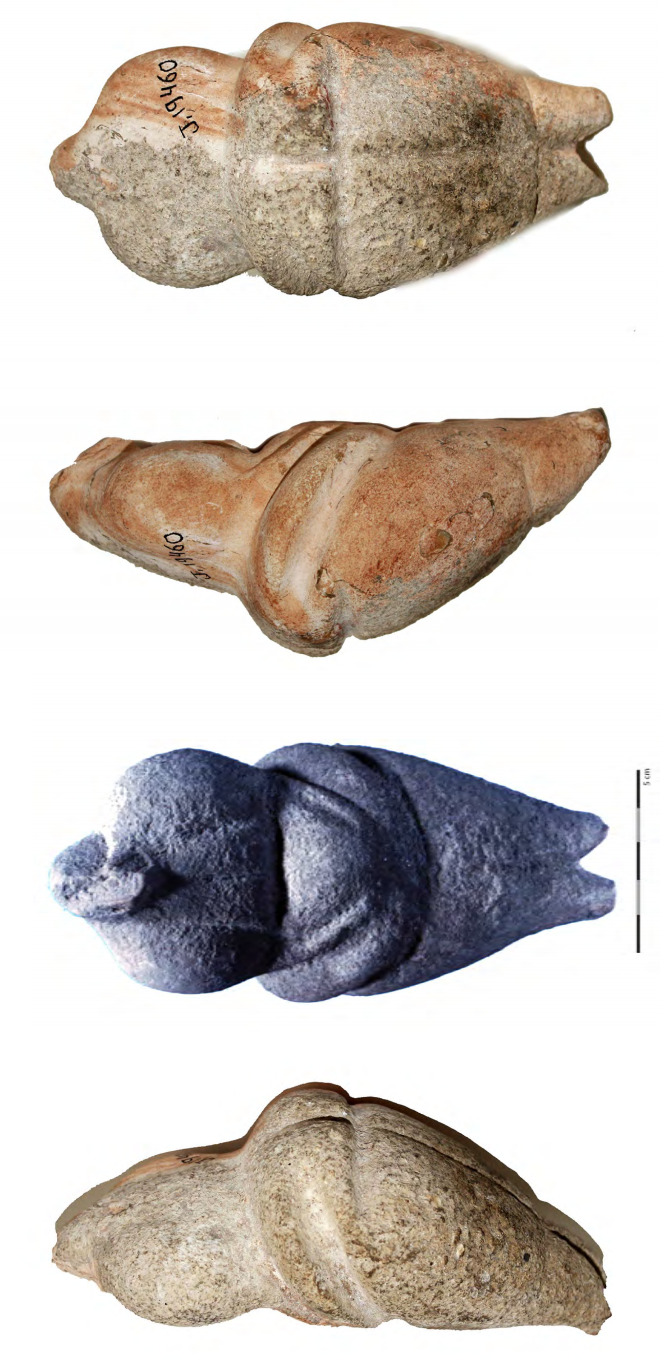
Page last updated: 1/19/20